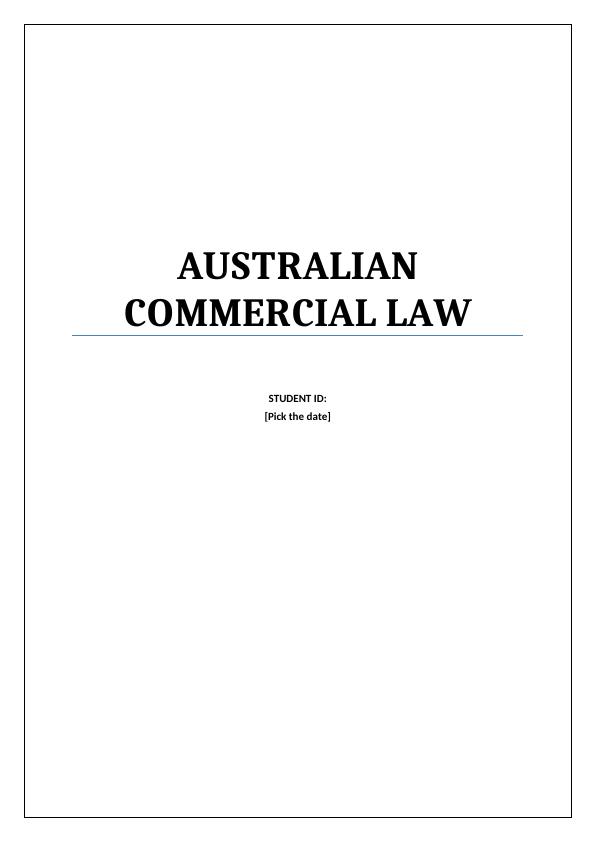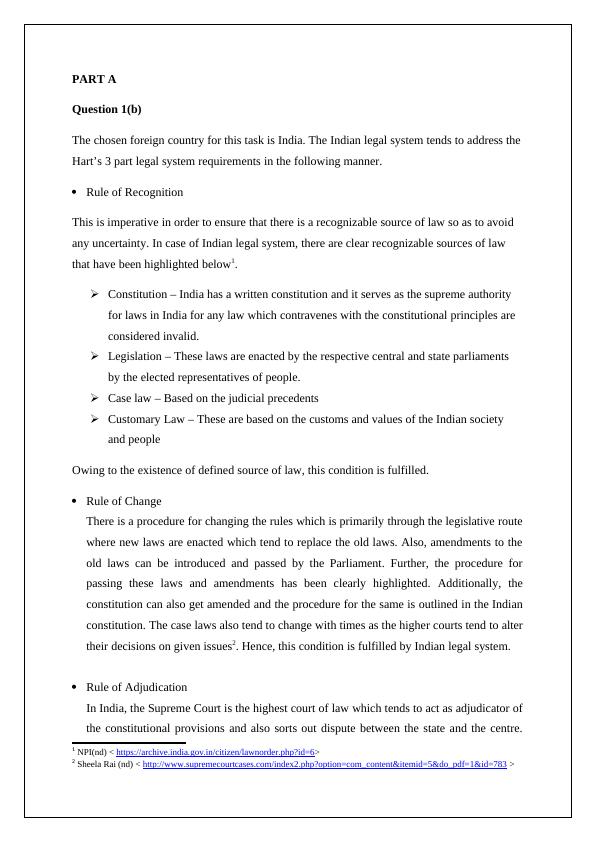Australian Commercial Law : Assignment
8 Pages2260 Words57 Views
Added on 2021-06-15
Australian Commercial Law : Assignment
Added on 2021-06-15
ShareRelated Documents
AUSTRALIANCOMMERCIAL LAWSTUDENT ID:[Pick the date]

PART AQuestion 1(b)The chosen foreign country for this task is India. The Indian legal system tends to address theHart’s 3 part legal system requirements in the following manner.Rule of RecognitionThis is imperative in order to ensure that there is a recognizable source of law so as to avoid any uncertainty. In case of Indian legal system, there are clear recognizable sources of law that have been highlighted below1.Constitution – India has a written constitution and it serves as the supreme authority for laws in India for any law which contravenes with the constitutional principles are considered invalid.Legislation – These laws are enacted by the respective central and state parliaments by the elected representatives of people.Case law – Based on the judicial precedents Customary Law – These are based on the customs and values of the Indian society and peopleOwing to the existence of defined source of law, this condition is fulfilled.Rule of ChangeThere is a procedure for changing the rules which is primarily through the legislative routewhere new laws are enacted which tend to replace the old laws. Also, amendments to theold laws can be introduced and passed by the Parliament. Further, the procedure forpassing these laws and amendments has been clearly highlighted. Additionally, theconstitution can also get amended and the procedure for the same is outlined in the Indianconstitution. The case laws also tend to change with times as the higher courts tend to altertheir decisions on given issues2. Hence, this condition is fulfilled by Indian legal system.Rule of AdjudicationIn India, the Supreme Court is the highest court of law which tends to act as adjudicator ofthe constitutional provisions and also sorts out dispute between the state and the centre.1NPI(nd) <https://archive.india.gov.in/citizen/lawnorder.php?id=6>2Sheela Rai (nd) <http://www.supremecourtcases.com/index2.php?option=com_content&itemid=5&do_pdf=1&id=783 >

Besides, the judiciary also has the power to put down any law formed by the Parliamentwhich tends to violate the basic principles of the constitution. Also, there is a hierarchy ofcourts to decide on various legal matters and adjudicate in case of disputes arising invarious domestic and commercial relations. Besides, there are also tribunals which tend todeal with administrative matters and tend to possess powers of adjudication. Therefore,there does exist a defined machinery of adjudication mechanisms in India to deal withvarious disputes3. Therefore, this condition is also satisfied.Based on the above discussion, it is apparent that the Indian legal system does comply withHart’s 3 part legal system. This is true also for Australia since it has a defined source of lawcomprising of constitution, common law, case law along with statute law. A difference fromIndia is that customary law seems to be absent through the tradition and custom are indirectlyrepresented through statute. Besides, the rules for change of law have been well defined andadhered to, thereby avoiding any unauthorised change. This is usually done through theParliament and also through latest developments in case law. Additionally, with regards toadjudication, there exists the Federal and State courts along with tribunals which tend tosought out any disputes that tend to arise from a host of issues. Thereby, it may beappropriate to derive the conclusion that the description of the legal system by Hart also fitstrue for Australia. PART BQuestion 2IssueBased on the facts provided, the key is to outline the relevant legal advice to Barryconcerning the validity of contract entered into with Angelo. Relevant LawMisrepresentation is a key concept which is applicable in contract law. It points to acircumstance where the seller has misrepresented material factual information with the3Rabindra Pathak Constitutional Adjudication in India: A Study with Special Reference to Basic Structure Doctrine (2013) <http://shodhganga.inflibnet.ac.in/bitstream/10603/56928/1/rabindra%20kr.%20pathak,%20ph.d.%20thesis.pdf>

End of preview
Want to access all the pages? Upload your documents or become a member.
Related Documents
Australian Commercial Law - Assignmentlg...
|7
|2106
|49
Australian commercial Law (PDF)lg...
|8
|2287
|163
Australian Commercial Law | Assignmentlg...
|8
|2440
|25
Laws20058 Australian Commercial Law PDFlg...
|8
|2417
|22
Commercial and Corporation Law Assignment PDFlg...
|9
|2427
|58
Australian Commercial Law (PDF)lg...
|11
|2505
|36
